STA10003 Statistics: Employee Engagement Data Analysis Report
VerifiedAdded on 2023/06/12
|6
|1012
|370
Report
AI Summary
This report analyzes employee engagement within a company using statistical methods. It examines the level of engagement with supervisors based on employee tenure (less than 5 years vs. 5 years or more) and gender. The analysis includes independent samples tests to determine if significant differences exist in engagement levels between these groups. Furthermore, the report investigates the difference between employee engagement with their team versus their supervisor using a paired samples test. Finally, it interprets a sampling distribution related to work-related emails and assesses whether a given sample aligns with that distribution, drawing conclusions about the population based on the statistical findings. The study uses data presumably from Indigo Insurance Company and applies statistical tests to address specific research questions related to employee experiences and perceptions.

RUNNING HEADER: STATISTICS 1
Statistics
Students Name:
Institution:
ID number:
Statistics
Students Name:
Institution:
ID number:
Paraphrase This Document
Need a fresh take? Get an instant paraphrase of this document with our AI Paraphraser
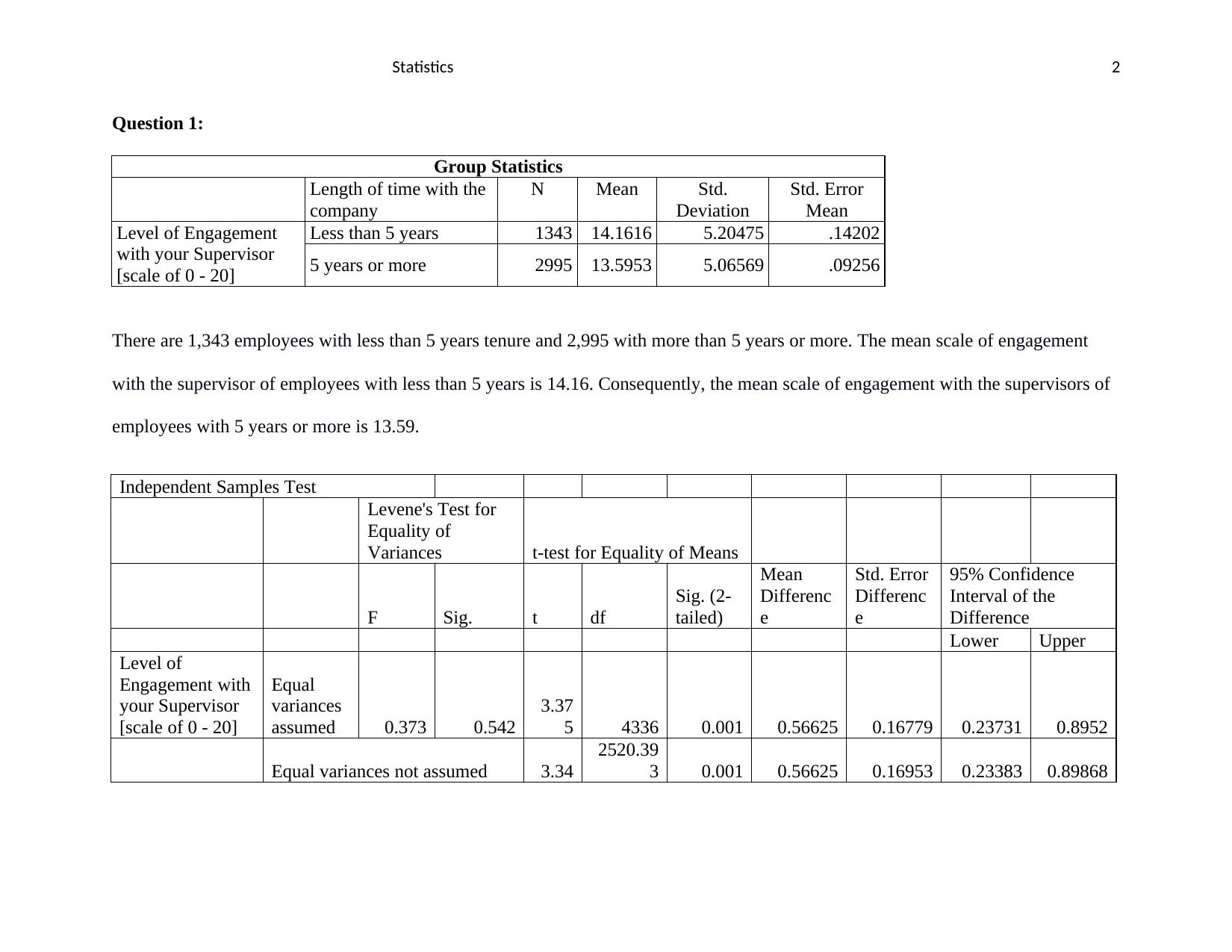
Statistics 2
Question 1:
Group Statistics
Length of time with the
company
N Mean Std.
Deviation
Std. Error
Mean
Level of Engagement
with your Supervisor
[scale of 0 - 20]
Less than 5 years 1343 14.1616 5.20475 .14202
5 years or more 2995 13.5953 5.06569 .09256
There are 1,343 employees with less than 5 years tenure and 2,995 with more than 5 years or more. The mean scale of engagement
with the supervisor of employees with less than 5 years is 14.16. Consequently, the mean scale of engagement with the supervisors of
employees with 5 years or more is 13.59.
Independent Samples Test
Levene's Test for
Equality of
Variances t-test for Equality of Means
F Sig. t df
Sig. (2-
tailed)
Mean
Differenc
e
Std. Error
Differenc
e
95% Confidence
Interval of the
Difference
Lower Upper
Level of
Engagement with
your Supervisor
[scale of 0 - 20]
Equal
variances
assumed 0.373 0.542
3.37
5 4336 0.001 0.56625 0.16779 0.23731 0.8952
Equal variances not assumed 3.34
2520.39
3 0.001 0.56625 0.16953 0.23383 0.89868
Question 1:
Group Statistics
Length of time with the
company
N Mean Std.
Deviation
Std. Error
Mean
Level of Engagement
with your Supervisor
[scale of 0 - 20]
Less than 5 years 1343 14.1616 5.20475 .14202
5 years or more 2995 13.5953 5.06569 .09256
There are 1,343 employees with less than 5 years tenure and 2,995 with more than 5 years or more. The mean scale of engagement
with the supervisor of employees with less than 5 years is 14.16. Consequently, the mean scale of engagement with the supervisors of
employees with 5 years or more is 13.59.
Independent Samples Test
Levene's Test for
Equality of
Variances t-test for Equality of Means
F Sig. t df
Sig. (2-
tailed)
Mean
Differenc
e
Std. Error
Differenc
e
95% Confidence
Interval of the
Difference
Lower Upper
Level of
Engagement with
your Supervisor
[scale of 0 - 20]
Equal
variances
assumed 0.373 0.542
3.37
5 4336 0.001 0.56625 0.16779 0.23731 0.8952
Equal variances not assumed 3.34
2520.39
3 0.001 0.56625 0.16953 0.23383 0.89868
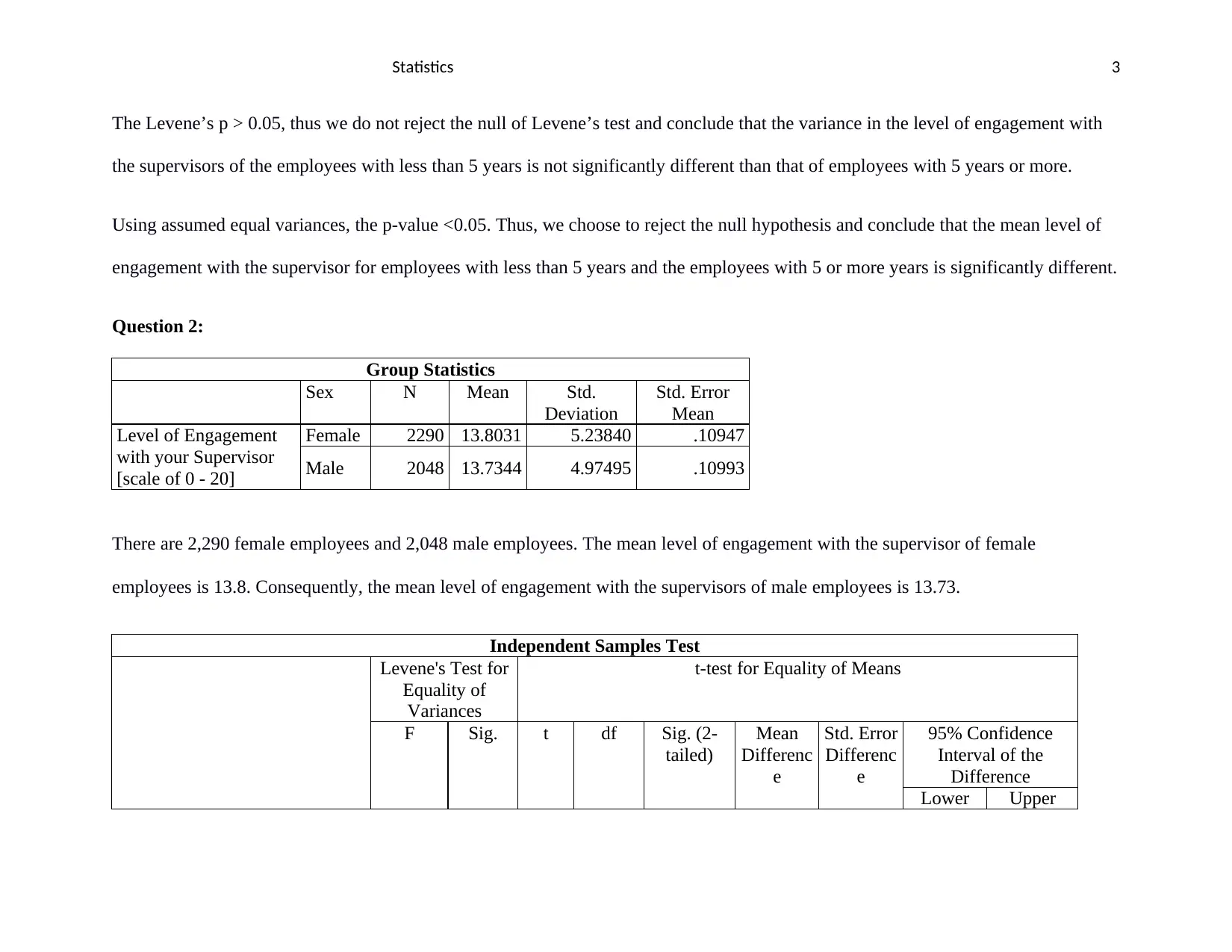
Statistics 3
The Levene’s p > 0.05, thus we do not reject the null of Levene’s test and conclude that the variance in the level of engagement with
the supervisors of the employees with less than 5 years is not significantly different than that of employees with 5 years or more.
Using assumed equal variances, the p-value <0.05. Thus, we choose to reject the null hypothesis and conclude that the mean level of
engagement with the supervisor for employees with less than 5 years and the employees with 5 or more years is significantly different.
Question 2:
Group Statistics
Sex N Mean Std.
Deviation
Std. Error
Mean
Level of Engagement
with your Supervisor
[scale of 0 - 20]
Female 2290 13.8031 5.23840 .10947
Male 2048 13.7344 4.97495 .10993
There are 2,290 female employees and 2,048 male employees. The mean level of engagement with the supervisor of female
employees is 13.8. Consequently, the mean level of engagement with the supervisors of male employees is 13.73.
Independent Samples Test
Levene's Test for
Equality of
Variances
t-test for Equality of Means
F Sig. t df Sig. (2-
tailed)
Mean
Differenc
e
Std. Error
Differenc
e
95% Confidence
Interval of the
Difference
Lower Upper
The Levene’s p > 0.05, thus we do not reject the null of Levene’s test and conclude that the variance in the level of engagement with
the supervisors of the employees with less than 5 years is not significantly different than that of employees with 5 years or more.
Using assumed equal variances, the p-value <0.05. Thus, we choose to reject the null hypothesis and conclude that the mean level of
engagement with the supervisor for employees with less than 5 years and the employees with 5 or more years is significantly different.
Question 2:
Group Statistics
Sex N Mean Std.
Deviation
Std. Error
Mean
Level of Engagement
with your Supervisor
[scale of 0 - 20]
Female 2290 13.8031 5.23840 .10947
Male 2048 13.7344 4.97495 .10993
There are 2,290 female employees and 2,048 male employees. The mean level of engagement with the supervisor of female
employees is 13.8. Consequently, the mean level of engagement with the supervisors of male employees is 13.73.
Independent Samples Test
Levene's Test for
Equality of
Variances
t-test for Equality of Means
F Sig. t df Sig. (2-
tailed)
Mean
Differenc
e
Std. Error
Differenc
e
95% Confidence
Interval of the
Difference
Lower Upper
⊘ This is a preview!⊘
Do you want full access?
Subscribe today to unlock all pages.

Trusted by 1+ million students worldwide
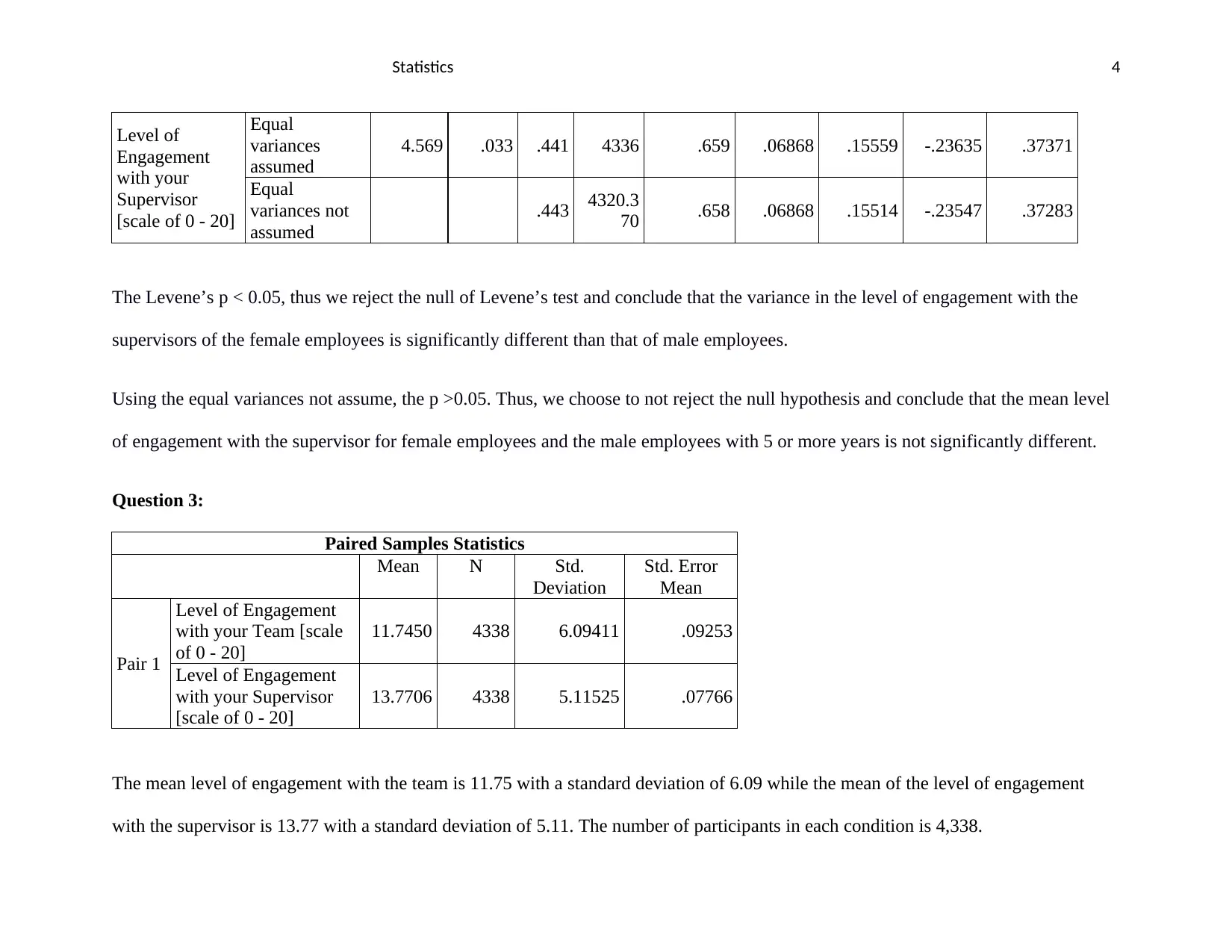
Statistics 4
Level of
Engagement
with your
Supervisor
[scale of 0 - 20]
Equal
variances
assumed
4.569 .033 .441 4336 .659 .06868 .15559 -.23635 .37371
Equal
variances not
assumed
.443 4320.3
70 .658 .06868 .15514 -.23547 .37283
The Levene’s p < 0.05, thus we reject the null of Levene’s test and conclude that the variance in the level of engagement with the
supervisors of the female employees is significantly different than that of male employees.
Using the equal variances not assume, the p >0.05. Thus, we choose to not reject the null hypothesis and conclude that the mean level
of engagement with the supervisor for female employees and the male employees with 5 or more years is not significantly different.
Question 3:
Paired Samples Statistics
Mean N Std.
Deviation
Std. Error
Mean
Pair 1
Level of Engagement
with your Team [scale
of 0 - 20]
11.7450 4338 6.09411 .09253
Level of Engagement
with your Supervisor
[scale of 0 - 20]
13.7706 4338 5.11525 .07766
The mean level of engagement with the team is 11.75 with a standard deviation of 6.09 while the mean of the level of engagement
with the supervisor is 13.77 with a standard deviation of 5.11. The number of participants in each condition is 4,338.
Level of
Engagement
with your
Supervisor
[scale of 0 - 20]
Equal
variances
assumed
4.569 .033 .441 4336 .659 .06868 .15559 -.23635 .37371
Equal
variances not
assumed
.443 4320.3
70 .658 .06868 .15514 -.23547 .37283
The Levene’s p < 0.05, thus we reject the null of Levene’s test and conclude that the variance in the level of engagement with the
supervisors of the female employees is significantly different than that of male employees.
Using the equal variances not assume, the p >0.05. Thus, we choose to not reject the null hypothesis and conclude that the mean level
of engagement with the supervisor for female employees and the male employees with 5 or more years is not significantly different.
Question 3:
Paired Samples Statistics
Mean N Std.
Deviation
Std. Error
Mean
Pair 1
Level of Engagement
with your Team [scale
of 0 - 20]
11.7450 4338 6.09411 .09253
Level of Engagement
with your Supervisor
[scale of 0 - 20]
13.7706 4338 5.11525 .07766
The mean level of engagement with the team is 11.75 with a standard deviation of 6.09 while the mean of the level of engagement
with the supervisor is 13.77 with a standard deviation of 5.11. The number of participants in each condition is 4,338.
Paraphrase This Document
Need a fresh take? Get an instant paraphrase of this document with our AI Paraphraser
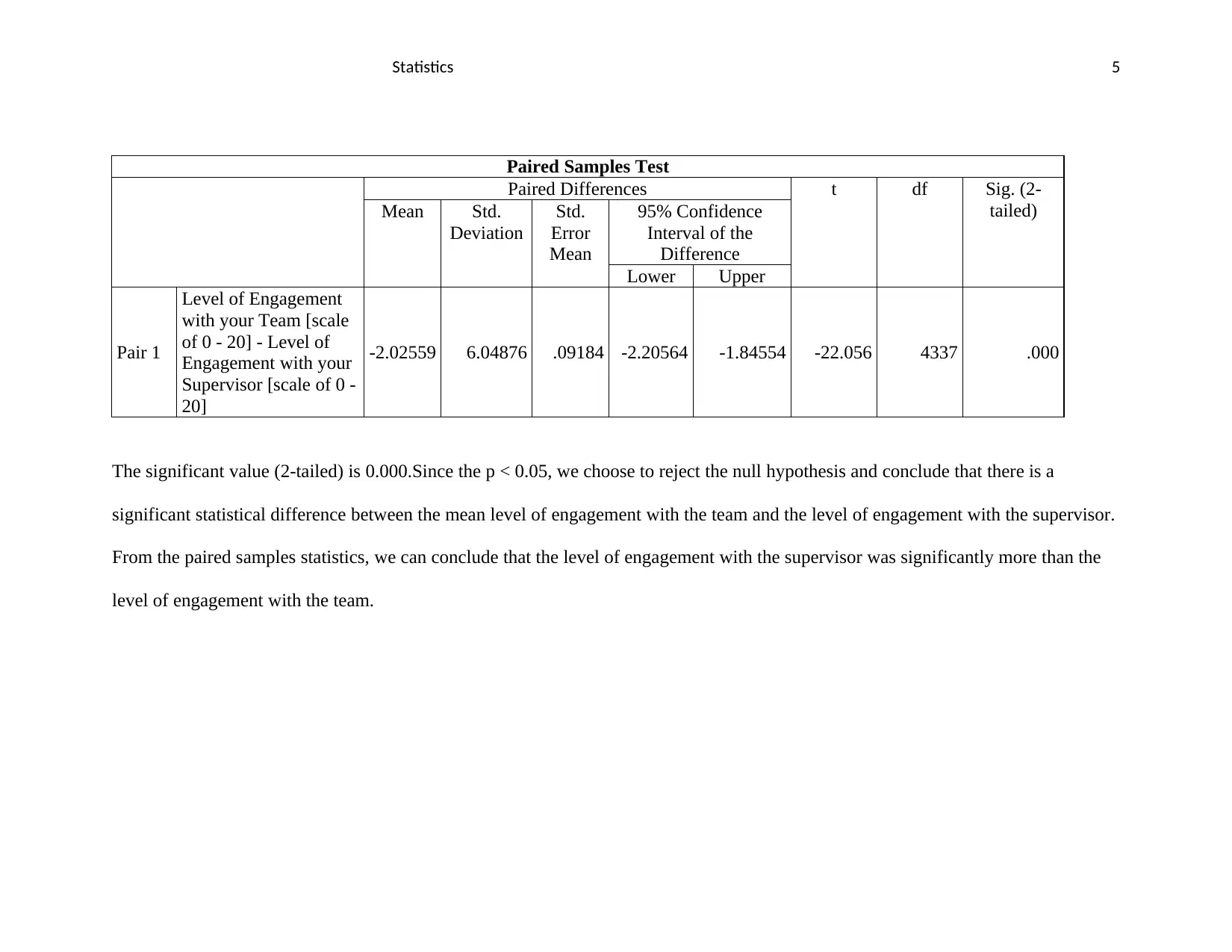
Statistics 5
Paired Samples Test
Paired Differences t df Sig. (2-
tailed)Mean Std.
Deviation
Std.
Error
Mean
95% Confidence
Interval of the
Difference
Lower Upper
Pair 1
Level of Engagement
with your Team [scale
of 0 - 20] - Level of
Engagement with your
Supervisor [scale of 0 -
20]
-2.02559 6.04876 .09184 -2.20564 -1.84554 -22.056 4337 .000
The significant value (2-tailed) is 0.000.Since the p < 0.05, we choose to reject the null hypothesis and conclude that there is a
significant statistical difference between the mean level of engagement with the team and the level of engagement with the supervisor.
From the paired samples statistics, we can conclude that the level of engagement with the supervisor was significantly more than the
level of engagement with the team.
Paired Samples Test
Paired Differences t df Sig. (2-
tailed)Mean Std.
Deviation
Std.
Error
Mean
95% Confidence
Interval of the
Difference
Lower Upper
Pair 1
Level of Engagement
with your Team [scale
of 0 - 20] - Level of
Engagement with your
Supervisor [scale of 0 -
20]
-2.02559 6.04876 .09184 -2.20564 -1.84554 -22.056 4337 .000
The significant value (2-tailed) is 0.000.Since the p < 0.05, we choose to reject the null hypothesis and conclude that there is a
significant statistical difference between the mean level of engagement with the team and the level of engagement with the supervisor.
From the paired samples statistics, we can conclude that the level of engagement with the supervisor was significantly more than the
level of engagement with the team.
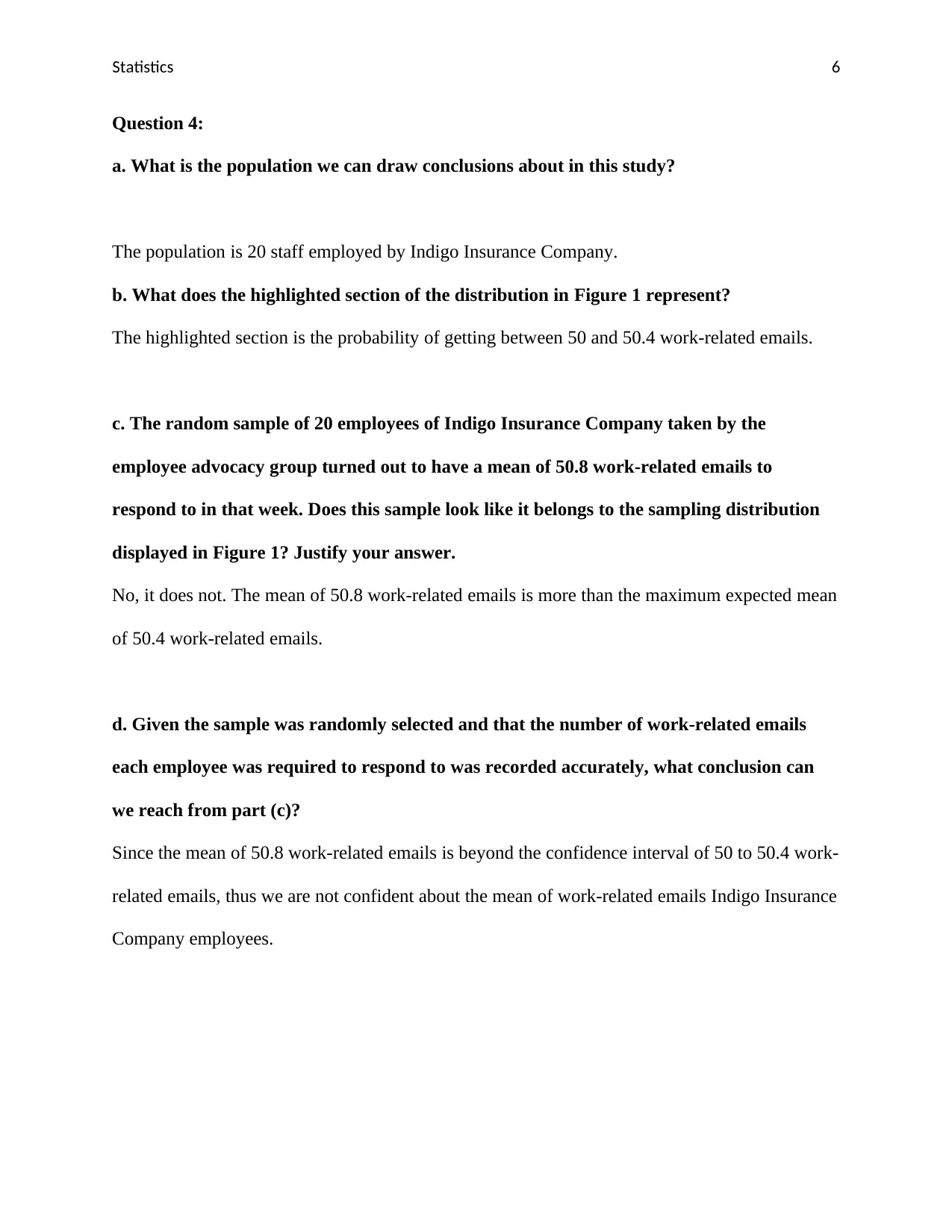
Statistics 6
Question 4:
a. What is the population we can draw conclusions about in this study?
The population is 20 staff employed by Indigo Insurance Company.
b. What does the highlighted section of the distribution in Figure 1 represent?
The highlighted section is the probability of getting between 50 and 50.4 work-related emails.
c. The random sample of 20 employees of Indigo Insurance Company taken by the
employee advocacy group turned out to have a mean of 50.8 work-related emails to
respond to in that week. Does this sample look like it belongs to the sampling distribution
displayed in Figure 1? Justify your answer.
No, it does not. The mean of 50.8 work-related emails is more than the maximum expected mean
of 50.4 work-related emails.
d. Given the sample was randomly selected and that the number of work-related emails
each employee was required to respond to was recorded accurately, what conclusion can
we reach from part (c)?
Since the mean of 50.8 work-related emails is beyond the confidence interval of 50 to 50.4 work-
related emails, thus we are not confident about the mean of work-related emails Indigo Insurance
Company employees.
Question 4:
a. What is the population we can draw conclusions about in this study?
The population is 20 staff employed by Indigo Insurance Company.
b. What does the highlighted section of the distribution in Figure 1 represent?
The highlighted section is the probability of getting between 50 and 50.4 work-related emails.
c. The random sample of 20 employees of Indigo Insurance Company taken by the
employee advocacy group turned out to have a mean of 50.8 work-related emails to
respond to in that week. Does this sample look like it belongs to the sampling distribution
displayed in Figure 1? Justify your answer.
No, it does not. The mean of 50.8 work-related emails is more than the maximum expected mean
of 50.4 work-related emails.
d. Given the sample was randomly selected and that the number of work-related emails
each employee was required to respond to was recorded accurately, what conclusion can
we reach from part (c)?
Since the mean of 50.8 work-related emails is beyond the confidence interval of 50 to 50.4 work-
related emails, thus we are not confident about the mean of work-related emails Indigo Insurance
Company employees.
⊘ This is a preview!⊘
Do you want full access?
Subscribe today to unlock all pages.

Trusted by 1+ million students worldwide
1 out of 6
Related Documents
Your All-in-One AI-Powered Toolkit for Academic Success.
+13062052269
info@desklib.com
Available 24*7 on WhatsApp / Email
![[object Object]](/_next/static/media/star-bottom.7253800d.svg)
Unlock your academic potential
© 2024 | Zucol Services PVT LTD | All rights reserved.





